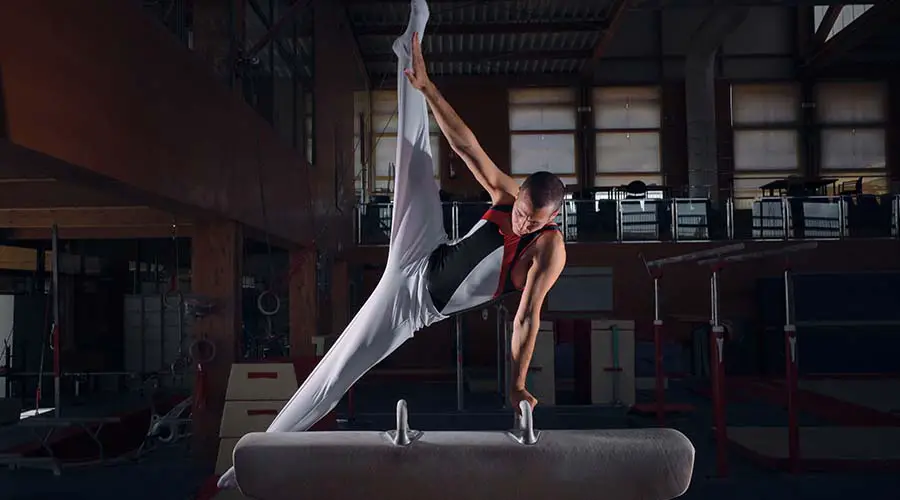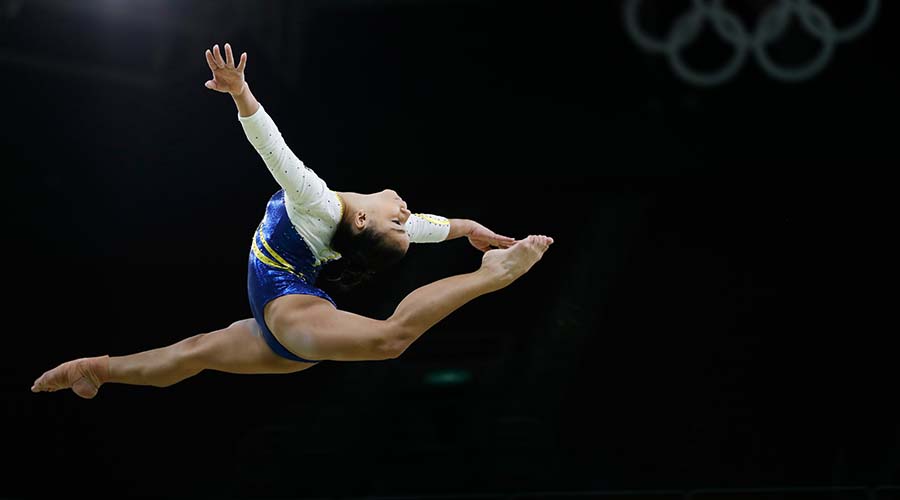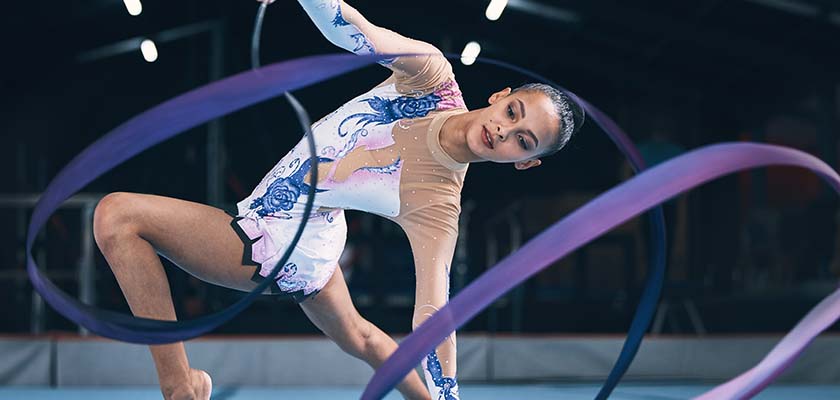One of the most remembered sports when it comes to the Olympics is definitely artistic gymnastics. The sport was created in Ancient Greece, many, many years ago, and consists of performing impressive acrobatic movements.
The sport’s history began as military training, as well as a form of entertainment that always appeared at sports and cultural festivals. Then, at the end of the 18th century, artistic gymnastics began to be modernized and turned into something serious, making great strides until it became what it is today.
If you like the sport and are curious about the types of artistic gymnastics, you’ve come to the right place! Get ready to immerse yourself in the universe of this incredible sport, which is about to attract attention at the Paris Olympics in 2024.
Check it out 👇
Participate in our free Whatsapp community and receive daily tips, news and trivia on over 50 sports! Click here to join.
Types of artistic gymnastics: history

First of all, we need to put the sport into context. The history of artistic gymnastics begins in ancient times, more precisely in Ancient Greece. The sport was widely practiced in school physical education classes and also in military training;
The aim of this activity was mainly to help strengthen the health of the competitors, as well as increasing their physical strength and, of course, improving their aesthetic appearance;
It wasn’t long before the sport began to be included in important sports festivals, those that preceded the old Olympic Games, over the years. But it wasn’t all smooth sailing.
Artistic gymnastics faced some difficulties, mainly due to historical events such as the rise of the Roman Empire and the growth of Catholicism. It wasn’t until the Renaissance, therefore, that people became interested in the sport again.
The sport then began to gain a lot more popularity, being developed and modernized more and more. Friedrich Ludwig Jahn, one of the most important names in the sport because he helped it grow, is known to this day as the “father of gymnastics”.
In the 20th century, the first international federation of the sport was founded in 1881, making artistic gymnastics internationally famous. In relation to the modern Olympic Games, the Olympics we know today, artistic gymnastics was made official as a sport in 1896 for men, and only in 1928 for women.
After understanding the historical context, it’s finally time to learn about the types of artistic gymnastics.
Types of artistic gymnastics: modalities
Artistic gymnastics is a sport divided into several disciplines, with different apparatuses and movements. It is divided into men’s artistic gymnastics and women’s artistic gymnastics;
Let’s take a look at each of the types of artistic gymnastics:

Men’s artistic gymnastics
- Grommets;
- Fixed bar;
- Parallel bars;
- Horse with straps;
- Solo.
Rings – Here, athletes make various movements based on balance and strength, and this happens by hanging from fixed rings.
Fixed bar – In this discipline, we see gymnasts performing their movements, such as spins, jumps and others, on a horizontal bar.
Parallel bars – Athletes perform movements on and in the middle of two parallel bars.
Horse with straps – You’ll see the athletes doing circular movements and what is also known as the “scissor movement”. All this on top of a horse consisting of a long base with handles attached.
Horse vault – In the horse vault, gymnasts have to run towards a trampoline, jump on it and perform acrobatics in the air, then land on a mat. Here, the judges will assess the distance and difficulty of the performance.
Solo – In the solo discipline, athletes perform their acrobatics on a large, straight, obstacle-free mat. They are rocked by music and need to be well synchronized.
Women’s artistic gymnastics
- Asymmetrical bars;
- I jump on the table;
- Balance beam.
Asymmetrical bars – On the asymmetrical bars, gymnasts perform a series of movements on two bars that are at different heights from each other.
Table Jump – Here, the gymnasts have to run towards a trampoline, then perform acrobatics in the air and land on a padded floor. The judges will analyze the height, distance, and difficulty of the movement.
Balance beam – On the balance beam, gymnasts perform acrobatic movements and, of course, balance on a narrow beam that is close to the floor.
Solo – Works in the same way as the male solo.
Types of artistic gymnastics: scoring
Now it’s time to understand how artistic gymnastics scoring works. The criteria assessed are as follows:
- Execution score;
- Difficulty score;
- Final score;
In the sport, athletes will be judged on their quality of execution, i.e. performing the best stunts both on the ground and in the air, and also taking into account the difficulty of each performance.
After the performances, the judges will score the athletes taking into account the sum of the marks obtained in the performances on each apparatus. Basically, then, the score is set by the judges based on the quality and precision of the movements;
The athlete who manages to deliver a complete presentation with all these factors will do best. Remember that penalties can reduce the score. What can cause this loss are technical faults, poor range of movement, non-compliance with rules and other factors.
Types of artistic gymnastics: competitions
To know everything about artistic gymnastics, we also need to know what the main championships are. The most prominent competition, of course, is the Olympics, which take place every four years. The daily dedication of sportspeople is mainly focused on the Olympic Games. It is also through these that gymnasts gain more and more notoriety.
But gymnasts also compete a lot in the Artistic Gymnastics World Championships, as well as the Artistic Gymnastics World Cup. In these competitions, gymnasts can compete individually or in teams, always representing their own countries.
Types of artistic gymnastics: training and injuries
Because it’s a sport that demands a lot from the body, training is rigorous, focusing on strength, technique, flexibility, physical conditioning and, most importantly, mental preparation. Athletes usually start practicing at a very young age, often as children, and in order to have good results in adulthood they must not stop practicing.
As the sport is quite intense, it’s also common for athletes to get injured, especially in the joints, so it’s not hard to see gymnasts who have had to take time out or even stop practicing the sport after hurting certain parts of their body. Therefore, training needs to focus on avoiding this damage.
Types of artistic gymnastics: great gymnasts
Artistic gymnastics has a number of important athletes, many of them Brazilian. Check out some of the main ones:
- Artur Zanetti (Brazil);
- Kohei Uchimura (Japan);
- Daiane dos Santos (Brazil);
- Nadia Comăneci (Romania);
- Daniele Hypólito (Brazil);
- Larisa Latynina (Russia);
- Gabby Douglas (United States).
If you’d like to know more about these gymnasts, let us know in the comments so we can make a guide and talk about their careers in sport!
Did you enjoy learning about the types of artistic gymnastics? Then keep browsing the site and engaging with the content, so we know how to bring you the best information!
Types of artistic gymnastics
- Hoops (men);
- Fixed bar (men);
- Parallel bars (men);
- Horse with straps (male);
- Solo (male);
- Asymmetrical bars (female);
- Table jump (women);
- Balance beam (female).



